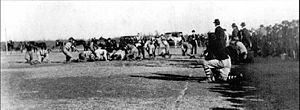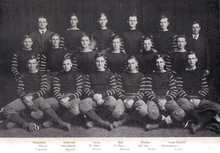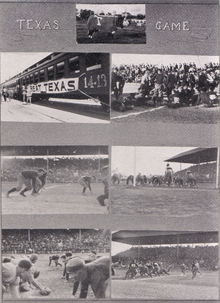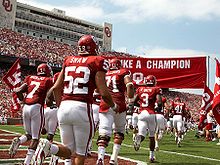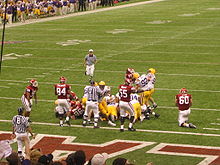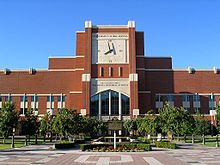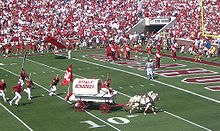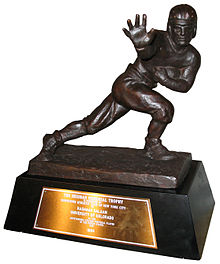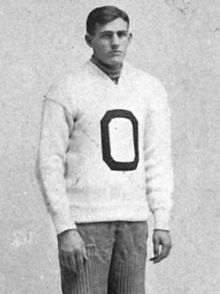- Oklahoma Sooners football
-
Oklahoma Sooners football  Current season
Current season
First season 1895 Athletic director Joe Castiglione Head coach Bob Stoops 12th year, 131–31 (.809) Home stadium Gaylord Family Oklahoma Memorial Stadium Stadium capacity 82,112 Stadium surface Grass Location Norman, Oklahoma Conference Big 12 All-time record 812–304–53 (.717) Postseason bowl record 26–17–1 Claimed national titles 7 Conference titles 43 Heisman winners 5 Consensus All-Americans 74 Current uniform 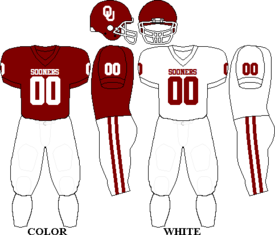
Colors Crimson and Cream Fight song Boomer Sooner Mascot Sooner Schooner Marching band The Pride of Oklahoma Marching Band Rivals Texas Longhorns
Nebraska Cornhuskers(former)
Oklahoma State CowboysWebsite SoonerSports.com The Oklahoma Sooners football program is a college football team that represents the University of Oklahoma (variously "Oklahoma" or "OU"). The team is currently a member of the Big 12 Conference, which is a Division I Bowl Subdivision (formerly Division I-A) of the National Collegiate Athletic Association (NCAA). The program began in 1895 and is the most successful program of the modern era (post World War II) with 567 wins and a winning percentage of .763 since 1945.[1][2] The program has seven national championships, 43 conference championships, 152 All-Americans (74 consensus),[3] and five Heisman Trophy winners. In addition, the school has had five coaches and 17 players inducted into the College Football Hall of Fame[4] and holds the record for the longest winning streak in Division I-FBS history with 47 straight victories. Oklahoma is also the only program that has had four coaches with 100+ wins, including current head coach Bob Stoops. They became the eighth NCAA FBS team to win 800 games when they defeated Utah State on Sept. 4th, 2010. The team is currently coached by Bob Stoops and games are played at the Gaylord Family - Oklahoma Memorial Stadium in Norman, Oklahoma.
Contents
History
For year-by-year results, see List of Oklahoma Sooners football seasons.Pre-Owen era (1895–1904)
The football program at the University of Oklahoma is the most famous aspect of Sooner athletics. Football at Oklahoma made its start in September 1895, 12 years before statehood and one year after the first organized football game in Oklahoma Territory. The team was organized by John A. Harts, a student from Winfield, Kansas who had played the game in his home state.[5] That first team was composed of mostly non-students, such as a local fireman. That first "season" saw the team go 0–1, being blanked 0–34 by a more experienced Oklahoma City Town Team (the Sooners could not even muster a first down). The first game was played on a field of low prairie grass just northwest of the current site of Holmberg Hall. Several members of the Oklahoma team were injured, including Coach Harts, and by the end of the game, the Oklahoma team was borrowing members from the opposing squad so they would have a full lineup. After that year, Harts left Oklahoma to prospect for gold in the Arctic.[6]
The team got its first real coach in 1897 when the new modern language professor, Vernon Louis Parrington, was drafted as head coach (they played two games in 1896 with no coach). Parrington played some football at Harvard and was more exposed to football because he was from the east coast. In his four years as head coach (1897–1900), Parrington's teams racked up nine wins, to one loss and two ties.[7] After the 1900 season, football began interfering with Parrington's teaching, his real passion. He stepped down as head coach shortly thereafter and went on to win the Pulitzer Prize for History in 1928 at the University of Washington.
The Sooners had three coaches over the next four seasons. Fred Roberts led the Sooners to a 3–2 season in 1901, Mark McMahon recorded an 11–7–3 record in his two years as coach from 1902 and 1903, and Fred Ewing recorded a 4–3–1 record in 1904.[7] The most notable event of those four years came in 1904 when Oklahoma had its first match against its instate rival, Oklahoma A&M. The game was played on November 6, 1904 at Mineral Wells Park in Guthrie, Oklahoma. The Oklahoma team soundly defeated the Oklahoma Aggies 75–0, but it was an unusual touchdown that is remembered most of that game.
“ The day was bitterly cold with blustery winds out of the north. The boundaries were vaguely defined. And one of the oddest touchdowns ever recorded in football history occurred when an Aggie punt was carried backward by the wind until it bounced into Cottonwood Creek. Players from both teams pursued the evasive football into the deeper, chilly waters of the creek, but it was a Rough Rider who prevailed and climbed ashore with the football. Incidentally, every player on the Oklahoma squad scored that day, soundly defeating the Aggies 75-0. ” —Taken from statue in Guthrie, Oklahoma. See photo.
Bedlam football, the athletic rivalry between the University of Oklahoma and Oklahoma State University, was born that day.
Owen era (1905–1946)
After ten years of football, the program began to get serious and started looking for a permanent coach, Bennie Owen. Owen was a quarterback on the undefeated Kansas team of 1899 led by famous coach Fielding H. Yost. Owen's previous team beat Oklahoma twice in 1903 and 1904, so the Sooners were familiar with his ability. Owen's first two years at Oklahoma were spent between Norman and Arkansas City as Oklahoma did not have in the budget enough funds to keep him there all year around. The early years of Owen's tenure were tough for budget reasons. Due to a low travel budget, his teams would regularly have to play as many as three games in one trek.[5] For instance, in 1905, his squad played three teams in three Kansas cities in five days and again in 1909 when they played three games in Missouri and Texas in six days. In Owen's first year, 1905, he gave Oklahoma its first victory over rival Texas, defeating them 2–0. Owen's first dominant team came in 1908 when they went 8–1–1, losing only to the powerful Kansas team. His 1908 team used hand-offs directly to large runners as the forward pass was just becoming common. His 1911 team, on the other hand, had several small and fast players that the quarterback would pass directly to. That team went 8–0. Owen had two more undefeated seasons in 1915 and 1918. 1920 was also Oklahoma's first season in the stronger Missouri Valley Intercollegiate Athletic Association. In the new conference, they went 6–0–1 tying only Kansas State University. During Owen's 22 year career at Oklahoma, he went 122–54–16, a 67.7% winning percentage.[7] In 1951, he became the first person from Oklahoma to be inducted into the College Football Hall of Fame. It was the inaugural year for the Hall of Fame and Owen was inducted along with many of the biggest names of the game including Walter Camp, Knute Rockne and Fielding H. Yost.
The next two coaches that came after Owen, Adrian Lindsey and Lewie Hardage, amounted to little, going a combined 30–31–10 over eight seasons. The next coach, Lawrence "Biff" Jones, went 9–6–3 in his two seasons at the helm, but he is credited for reining in the athletic department's administration, finances, and methods. The whole football program was placed on a solid footing necessary for success in modern times.[5] Jones was a "blunt-spoken, hard-nosed military man" who graduated from West Point in 1917.[8] Jones coached Army from 1926 to 1929 and then was the head coach of Louisiana State University. He was fired from LSU after refusing then-governor Huey Long's request to address the team during halftime of a game.[9] His tenure at Oklahoma came during the Dust Bowl. The dust storms were so thick it would block the sun and the players would be covered in dust at the end of practice.[8] In 1954, Jones was inducted into the College Football Hall of Fame. In 1937, Tom Stidham became the coach. Stidham took the solid footing put in place by Jones and stood on it. In his four seasons, Stidham's team went 27–8–3 for a winning percentage of 75%.[7] When he left in 1941, his assistant coach, Dewey Luster succeeded him. After Luster's first season, a 6–3 season, the Japanese attacked Pearl Harbor. As was the case with schools all over the country, many players left the team to join the military.[5]
Luster stepped down after the 1945 season due to ill health. The OU Board of Regents interviewed several candidates for the new head coaching job and one of those men was Jim Tatum. With him, he brought another coach, Bud Wilkinson, who would be his assistant coach. The Board was so impressed with Wilkinson that they considered hiring him for the head coaching position but decided against it as it would be unethical.[10] In the end, they decided to hire Tatum and his assistant over several other coaches including Paul "Bear" Bryant. Tatum had a relatively successful season finishing with an 8–3 record including a 73–12 win over Oklahoma A&M. When Tatum left for Maryland after the 1946 season, Wilkinson stepped up.
Wilkinson era (1947–1963)
Bud Wilkinson was a quarterback for the University of Minnesota and won three straight national championships with them in the 1930s. His coaching career began at Syracuse University and then at his alma mater Minnesota. After his service in the U.S. Navy in World War II, he began coaching at a naval academy in Iowa with Jim Tatum. When Tatum came to Oklahoma, he brought Wilkinson with him. Wilkinson went 7–2–1 in his first year and shared the conference title with Kansas for the second year in a row.
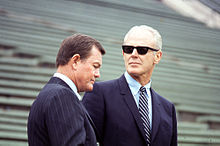 Bud Wilkinson with former quarterback Darrell Royal later in life.
Bud Wilkinson with former quarterback Darrell Royal later in life.
In 1949, the Sooners went undefeated, defeating LSU 35 to 0 at the Sugar Bowl. However, the game is best known for the "spy incident" since former LSU player Piggy Barnes was caught spying on the Sooner's practices.[1] Despite going undefeated and winning their bowl game, the Sooners were denied a national championship since it was awarded to Notre Dame, a team that did not play in a bowl game.[2] Wilkinson went on to guide the team to its first national championship in 1950 despite the fact that they lost The Sugar Bowl to Bear Bryant's Kentucky (11–1) team which made them Co-National Champions with Kentucky since AP voting took place before the Sugar Bowl game was played. That loss was the Sooners' first loss since a season opener loss to Santa Clara University in 1948, 31 games earlier. It was in 1951, while seeking funding to improve the university that president George Cross said to the Oklahoma legislature that he "would like to build a university of which the football team would be proud."[11] In 1952, Oklahoma had its first Heisman Trophy winner in halfback Billy Vessels, a local player from Cleveland, Oklahoma. In 1953, the Sooners opened with a loss to Notre Dame and tied Pittsburgh the next week. The Sooners would not lose another game for more than three years when they faced Notre Dame in November 1957, losing 7–0.[12]
Author Steve Budin, whose father was a New York bookie, has recently publicized the claim that the 1954 Bedlam game against OSU was fixed by mobsters in his book Bets, Drugs, and Rock & Roll (ISBN 1-602-39099-1).[13] Allegedly, the mobsters threatened and paid off a cook to slip laxatives into a soup eaten by many OU Sooner starting players, causing them to fall violently ill in the days leading up to the game. OU was victorious in the end, but their 14-0 win did not cover the 20-point spread they had in their favor. However, many people involved in the 1954 contest do not recall any incident like the one purported by Budin to have occurred.[14]
Wilkinson and his Sooners set a record with 47 consecutive wins, a record that has been seriously threatened only twice—by Miami and the University of Southern California, both in the past decade. During this streak, the Sooners won the national championship in 1955 and 1956. Additionally, the Sooners won or shared 14 straight conference titles from 1946 to 1959, one under Tatum and 13 under Wilkinson. The closest any team in the Big 8/Big 12 alone has come to matching it is the Sooners' run of eight straight titles (two of them shared) from 1973 to 1980. The Sooners also went undefeated in conference play from November 23, 1946 season through October 31, 1959; their record was only blemished by two ties. This record has never been seriously threatened by any team in what is now the Football Bowl Subdivision; in the Big 8/Big 12 alone, no team since has gone undefeated in conference play more than three years in a row.[citation needed]
Wilkinson's best teams came during the first eleven years of his tenure. In that time, he recorded winning streaks of 31 and 47 games and went 114–10–3, a winning percentage of 90.9%. Wilkinson left Oklahoma after the 1963 season with a record of 145–29–4, 14 conference titles and 123 straight games without being shut out.
During Wilkinson's tenure, another first would be recorded, just not in the record books. Prentice Gautt would become the first black football player at the University of Oklahoma. Gautt had been a superior student at an Oklahoma City high school. He was a member of the National Honor Society and president of his senior class. During his junior and senior years of high school, he helped his team amass a 31 game win streak. He was also the first black player to participate in the state all-star game.[15] Gautt was not the first black player to try out for the team, three others had two years earlier. The second black athlete to attend OU and play was Wallace Johnson. He joined the team during Gautt's sophomore year (Gautt & Johnson played together at the same Oklahoma City High School, Douglas HS). Two others could not afford to continue and dropped out, and Johnson ended his time there with an injured ankle. Because of Gautt's academic success in high school, he was supported financially by a group of local black doctors and pharmacists. A couple months into his freshman year, Gautt was placed on athletic scholarship and the money was returned to the investors. Unfortunately, members of Gautt's team were not as excited to play with him as he was with them. One player even left Oklahoma because he refused to play with an African American.[15] However, Gautt's attitude eventually grew on them. After a freshman game in Tulsa, Gautt was refused service in the restaurant where the team was scheduled to eat. His teammates abruptly left and found an eating establishment that would also serve him.[15] Oklahoma also had to stay at a different hotel during Gautt's eligibility in Fort Worth, Texas because their normal hotel did not permit African Americans.[15] Gautt broke out as a player in 1958. In 1959, he was named the Orange Bowl MVP. He was inducted into the College Football Hall of Fame in 1985.
Jones-MacKenzie-Fairbanks era (1964–1972)
Wilkinson's assistant coach, Gomer Jones, took over as head coach in 1964, a move Wilkinson engineered himself. His first year would prove to be a sharp contrast from Wilkinson's early years as the Sooners went 6–4–1.[16] The season saw them start 1–3 with three consecutive losses to Southern California, Texas and Kansas. But the hardest loss came in the Gator Bowl to Florida State. Prior to the game, it was found that four of the better players had signed professional football contracts before their college eligibility had expired. Those four were dismissed from the team prior to the bowl game.[17] Oklahoma lost this game 36–19. The next season's team fared no better, going 3–7, Oklahoma's worst record, percentage wise, since it went 0–1 its inaugural season in 1895. This brought the Jones era to a quick close, although he did remain at Oklahoma as the athletic director, a role he also held when he was head coach.
Following Jones's 9–11–1 record, Oklahoma brought in a young coach from the University of Arkansas named Jim Mackenzie. He wanted discipline for his team so he set a curfew for his players and required them to enroll in physical education class.[18] His season saw an improvement from the previous, but it still did not meet the expectations of Sooner football that Wilkinson had set. The 1966 team went 6–4 with a win in the Red River Shootout over rival Texas coached by former Oklahoma defensive back Darrell Royal, their first win over Texas since 1957. They also beat the number four team in the nation, rival Nebraska by a score of 10–9. The 1966 season showed promise for the young coach, but, on April 28, 1967, at the age of 37, Mackenzie died of a heart attack.
After the 1964 season, Chuck Fairbanks, an assistant coach at the University of Houston, was offered a job at Tennessee. He wanted to accept, but it was the middle of the summer and unusually late for a coaching move, so he decided to stay loyal to Houston and he remained there. After the next season, he was offered a position as an assistant on Mackenzie's staff at Oklahoma, a position he felt was a better job than the Tennessee position.[19] Immediately after the 1965 season, Fairbanks was offered a job at Missouri with the promise that he would be the head coach within four years.[19] He declined and stayed at Oklahoma. Four months later, Coach Mackenzie died and Fairbanks was named head coach. It did not take long for Fairbanks to turn the team around. His first season, in 1967, his squad went 10–1. They entered their sixth game with a 5–1 record (their only loss was a two point loss coming to rival Texas) and unranked[20] and beat ninth ranked Colorado, 23–0. This propelled Fairbanks's team to a number eight ranking. They continued their romp through the season and beat the number two team in the country Tennessee 26–24 in the Orange Bowl. They finished the season ranked number three in the country.
Fairbanks lost four games in each of the next three seasons. Despite the relatively mediocre record of those years, several great players came through Fairbanks' program. One of those players was Steve Owens. Owens was born in Gore, Oklahoma in 1947. After an impressive year in 1969, despite Oklahoma's record, Owens was named the Sooners' second Heisman Trophy winner. Many[who?] believe that Owens saved Fairbanks' career by helping defeat rival Oklahoma State.[8]
It did not take long for Fairbanks to return the team to form. His 1970 team tied Bear Bryant's Alabama team in the Bluebonnet Bowl to finish as the number 20 team in the country. They began the 1971 season ranked number ten. In consecutive weeks, they beat number 17 Southern California, number three Texas, and number six Colorado.
These early-season wins propelled them to a number two national ranking and set the stage for one of the great college football games of the century against top-ranked Nebraska.[21] Oklahoma was led by quarterback Jack Mildren and running back Greg Pruitt. The team was a scoring machine, averaging 44.5 points per game, the second highest in team history.[22] Equally impressive that season was Pruitt's nine yards per carry. On November 25, 1971, Nebraska edged Oklahoma, 35–31 in what was to be the only loss of the season for Oklahoma. Oklahoma went on to beat Oklahoma State and fifth ranked Auburn to finish the season ranked number two.
Fairbanks closed out his career at Oklahoma the following year with a win in the Sugar Bowl over Penn State after having lost once all season, to Colorado. Following this season, Fairbanks accepted a position with the NFL's New England Patriots. He left behind a mess for the new head coach, Fairbank's offensive coordinator, Barry Switzer.
Switzer era (1973–1989)
As an offensive coordinator in 1971, Barry Switzer perfected the wishbone offense as it led the nation in both scoring (45 points average) and total yards (563 total yards average), and set a NCAA record by averaging over 472 rushing yards. The Sooners finished the season ranked #2, losing only once, 35–31 to eventual national champion Nebraska in the Game of the Century. [3] When Chuck Fairbanks accepted the position of head coach of the New England Patriots following the 1972 season, Switzer was the obvious choice to succeed him.
Soon after Barry Switzer took the reins of the program, the NCAA forced Oklahoma to forfeit nine games from the 1972 season due to violations involving the alteration of transcripts. Fairbanks denied any knowledge of this. As a punishment, the Sooners could not play in a bowl game for two years. This setback did not stop Switzer's Sooners. His 1973 team finished 10–0–1 with only a tie to the number one ranked USC team.[23] They finished the season ranked number three after beating seven teams ranked in the top 20. He showed no signs of slowing down the next season either. Switzer's team finished 11–0 and won the national championship. This was the Sooners' first undefeated season and national championship since 1956. That team was another high scoring team averaging 43 points per game[22] and was anchored by Steve Davis at quarterback, Joe Washington at running back and the Selmon brothers (Lee Roy, Lucious, and Dewey) on defense.
Switzer's teams in the 1970s went a combined 73–7–2 in seven years.[24] In 1978, Oklahoma would get its third Heisman Trophy winner in running back Billy Sims. That year, he set the Oklahoma record for most rushing yards in a season with 1,896, a record that would stand for 26 years. His 1978 season currently ranks third in team history in yards per attempt with 7.41, behind fellow Sooners Greg Pruitt and Marcus Dupree.[25] Sims also holds the record at Oklahoma for most rushing yards in a career with 4,118.[26] He finished second in the Heisman race the following year, 1979.[27]
The early 1980s saw the Sooners begin to slip under Switzer. They lost four games in 1981, 1982, and 1983. It was the first time they lost four games in a season since 1970 under Coach Fairbanks. However, eight of those twelve losses came to the likes of USC, Texas, Nebraska and Ohio State. They began to turn around in 1984 when they went 9–2–1 and were ranked number six at the end of the season. The 1984 team featured Buster Rhymes at wide receiver, Spencer Tillman at running back and Tony Casillas at defensive tackle. Over the next three years, the team continued to grow and went 11–1 each of those three years (with all three losses coming to Miami), including a national championship in 1985 (they finished ranked number three in 1986 and 1987).[28] Many great Sooner athletes came through the program during these years, including two-time Butkus Award winner Brian Bosworth, tight end Keith Jackson and quarterback Jamelle Holieway. While Switzer was not able to match Wilkinson's unimaginable string of 13 consecutive conference championships, he was able to rack up 12 of his own during his career at Oklahoma.
In 1988, it all came crashing down for Switzer. His team was placed on probation by the NCAA for violating several rules. In a six month time frame, there was a shooting and a rape in the athletic dorm on Oklahoma's campus, Switzer's house was robbed with the help of one of his athletes, and an athlete was caught attempting to sell drugs to an undercover agent.[29] The three year probation included a two-year ban on TV and bowl appearances and a reduction in scholarships from 25 to 18.[30] Nonetheless, the 1988 team established the current NCAA FBS single-game record of 768 yards rushing against Kansas State on October 15, 1988.[31]
Gibbs-Schnellenberger-Blake era (1990–1998)
Switzer was succeeded by his longtime defensive coordinator, Gary Gibbs. Gibbs appeared to be a solid choice, having spent more than two decades at OU as a player and assistant coach. He went 44–23–2 in six years, and largely succeeded in cleaning up the program's image. However, even though his rosters were smaller than normal due to the scholarship reductions, Gibbs found it hard to please boosters and administrators with an 8-3 year. Ultimately, it was his record against Oklahoma's major rivals that did him in. Gibbs went 2-15-1 against Texas, Nebraska and Colorado. In addition to his record, he was thought to be uncomfortable around alumni, the media, and with being a head coach in general.[30]
To replace Gibbs, Oklahoma looked towards the seasoned Howard Schnellenberger, then 61 years old. Schnellenberger had won a national championship at Miami and turned around a once-moribund Louisville program. In the end, he was almost too sure of himself. He was quoted as saying, "They will write books and make movies about my time here."[30] His 1995 team started out well, reaching the top 10 after a 3-0 start. However, an embarrassing loss to Colorado on national television started a downward spiral. The Sooners ultimately finished 5–5–1, including only their second losing conference record since World War II. Schnellenberger resigned a month after the season ended. To this day, Schnellenberger is not held in high esteem by Sooner fans, in part because he made no secret of his lack of interest in the program's history. For instance, he vowed to make "Sooner Nation" forget about Wilkinson and Switzer—a boast considered to be almost heretical by the fan base. He ordered numerous old files to be thrown out; instead, they were archived without his knowledge.[30]
For the 1996 season, Oklahoma hired former player John Blake. Blake was the favorite to succeed Schnellenberger and was backed by Barry Switzer, Steve Owens, and former Oklahoma president George Lynn Cross.[30] However, many were skeptical of Oklahoma's choice for the new coach. His coaching experience was very limited, especially compared to his predecessor. In his seven-year coaching career (four years at OU, three years with the Dallas Cowboys and one year at Tulsa), he had never been more than a position coach. The skeptics were proven right. In Blake's first season, he went 3–8. It was the worst record, percentage wise, Oklahoma had experienced since 1895 and is tied for the most losses in one year (along with Blake's 1997 squad) to this very day. In his three years at Oklahoma, Blake went 3–8, 4–8, and 5–6. It was the first time since 1922–1924 that Oklahoma had three consecutive losing seasons. Blake's largest contribution to the team was his recruiting. He set the stage by recruiting several players that would help lead the program's resurgence, including J.T. Thatcher, Josh Norman, Roy Williams and Rocky Calmus. Many of them got a chance to play fairly quickly, since Blake's teams were often out of games early.
Stoops era (1999–present)
Main article: Oklahoma Sooners football under Bob Stoops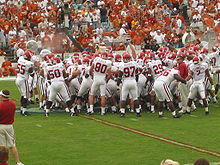 Players before the OU-Texas game in 2003. NFL players Dan Cody and Tommie Harris are easily visible in this photo.
Players before the OU-Texas game in 2003. NFL players Dan Cody and Tommie Harris are easily visible in this photo.
The university looked at many candidates to replace Blake. Many big-time college coaches were considered for the post. However, Oklahoma athletic director Joe Castiglione decided to hire a 38 year old defensive coordinator from Florida, Bob Stoops. Mr. Stoops was a former defensive back at Iowa under coach Hayden Fry and was his team captain and MVP. Coach Stoops quickly began to build his new program with the promise to help the program regain its former position as a perennial college football powerhouse. On his arrival to campus he would find that for all his predecessor's failings as a head football coach, John Blake had been an excellent recruiter and many of his players were potential stars. Despite the obvious talent already on-campus, no quarterback suitable for the "spread" offense was on the team roster. Stoops would remedy this by signing a little-known junior college quarterback, Josh Heupel, to run his offense. In his first year as head coach, the Sooners showed marked improvement; starting the season with three wins over non-conference opponents amassing 132 points to their opponents' 31. They lost the next two games, which included a 34-30 loss against Notre Dame at South Bend and finished the season with an overall record of 7 wins and 5 losses. This success was a breath of fresh air for a program that had fallen from perennial powerhouse to league doormat and those surrounding the Sooner football program expected great things from their new head coach. They would not be disappointed.
In 2000, the Sooners opened the season ranked number 19,[32] the first time they opened the season ranked in five years. The Sooners opened 4–0, dominating their early season opponents by a combined score of 176–51. The annual Red River Shootout against arch-rival the University of Texas would prove to be the first signature victory of the Bob Stoops era. The Sooners dominated the Longhorns by a score of 63-14 in what was then the most lopsided upset in the history of the rivalry. Oklahoma running back Quentin Griffin smashed the Oklahoma record for most touchdowns in a game with six scores. The Sooners were now officially back in the hunt for a national title. In the following weeks the team narrowly beat the number two ranked Kansas State 41–31 in Manhattan and the following week went on to beat the number one ranked Nebraska Cornhuskers 31–14. ESPN's Brent Musburger said that, "The Sooners' October run of burying Texas, Kansas State and Nebraska is one of the greatest 30-day stretches in college football history."[33] The Sooners narrowly escaped a loss at the hands of Texas A&M in College Station but they pulled out a victory, winning 35–31 on an interception return for a touchdown by linebacker Torrence Marshall. The team defeated the Kansas State Wildcats for the second time that season in the Big 12 Championship, a victory which propelled the program to its first national title berth since 1985. The Sooners finished the season with a stunning 13-2 win over a heavily favored Florida State team in the 2001 Orange Bowl and claimed the Sears Trophy. At the end of the season, quarterback Josh Heupel had the top two spots on the list of Oklahoma's season passing records. The championship was the Sooners' 7th national title and their first since Barry Switzer's departure. The team had finally regained its status as a power in the college football world. The stoic coach from Ohio had resurrected a football giant, bringing the once great program back to the pinnacle of college athletics. The Sooners and their fans were hungry for more success and Coach Stoops would deliver.
OU won the 2003 Rose Bowl after the 2002 season, and the team's national success continued in the 2003 and 2004 seasons. The 2003 team was the highest scoring squad (at the time) in Oklahoma's storied history, scoring 601 points to their opponents 214. The season included seven games of 50 points or more with the highlights including a 77–0 drubbing of Texas A&M and a 65–13 defeat of Texas. The team, led by Heisman Trophy winner Jason White, was billed as one of "the greatest college football teams of all time." This assumption was short-lived as the Sooners were upset in the Big 12 Championship Game by Kansas State. Due to their impressive strength of schedule, the Sooners were able to retain their position in the polls and their chance for the title. In a warm night in New Orleans, the Sooners were handed their second consecutive defeat and their first title loss; this time to the LSU Tigers squad by a score of 21-14. The heartbreaking defeats shocked the Sooner nation while conversely establishing the team as a perennial title contender. In 2004, the Sooners were able to reach the 2005 Orange Bowl undefeated, along with the USC Trojans. Although the Sooners lost in the title game 55-19, USC later vacated the win due to NCAA infractions.
In 2005, Stoops finished the season with an 8-4 record, his worst season record since his inaugural season. Jason White's backup, Paul Thompson, was named starting quarterback at the beginning of the season, but was replaced by redshirt freshman Rhett Bomar after a season-opening loss to TCU. Paul Thompson was moved to the wide receiver slot for the rest of the season. They started the season 2–3 with additional losses against UCLA (at UCLA) and against eventual national champion Texas. The team started to improve as the season progressed, especially the young Bomar. The next loss came against Texas Tech and was a controversial loss. Texas Tech's Taurean Henderson scored on the final play of the game. The play was reviewed by replay officials, but video replays were deemed inconclusive.[34] The touchdown gave the Red Raiders the win, 23-21. It was a setback for the Sooners but they moved on and were able to soundly defeat their instate rival Oklahoma State in Norman by a final score of 42–14. The Sooners finished third in the Big 12 South behind the 2005 Texas Longhorns (who went on to win the 2005 BCS National Championship) and the Texas Tech Red Raiders (Oklahoma and Texas Tech both had conference records of 6–2, but Texas Tech won the heads up match and thus was placed over Oklahoma). The unranked Sooners would represent the Big 12 in the Holiday Bowl and they would play the sixth-ranked Oregon Ducks. Oklahoma went on to beat the Ducks, 17–14; Bomar was named the Bowl MVP and the Sooners finished the season ranked #22.[20] On July 11, 2007, the NCAA announced that the Sooners would have to vacate all victories from the 2005 season, including the bowl game, due to NCAA violations related to three former players, including Bomar, thereby giving the Sooners an official 2005 record of 0–4.[35] However, on February 22, 2008, the NCAA reversed the decision and reinstated the vacated wins.[36]
2006 was a very tumultuous year for the Sooners. One day before fall practice began, returning quarterback Rhett Bomar and J.D. Quinn, a projected starter on the offensive line, were kicked off the team for violating NCAA rules when they received payment for work they did not do. Paul Thompson, who had played wide receiver in 2005 and had not practiced in the quarterback role for nearly a year, was asked to move back to quarterback which he did. In mid-September, Oklahoma played the University of Oregon for the third time in three years. The Sooners lost this game 33–34. During the game a controversy arose when game officials awarded an onside kick to the Ducks when it should have been Oklahoma's ball.[37][38] Following the game, all officials were suspended for one game but replay official Gordon Riese said he would take the year off;[37] later in the year, he would quit completely.[39] Gordon Riese later acknowledged that he knew Oklahoma recovered the onside kick but replay rules prevented him from correcting the on-field officials.[40] A few weeks later, Oklahoma lost to rival Texas. Following these setbacks, the team regrouped and the defense vastly improved. Following the Oregon game, the defense was ranked 97th nationally[41] but by the end of the regular season, they were ranked 17th.[42] Following the Texas game, Oklahoma played Iowa State and soundly defeated them 34–9. However, on the final touchdown drive for the Sooners, star running back Adrian Peterson suffered a broken collar bone when he attempted to dive into the end zone in a celebratory manner.[43] The Sooners would turn to two untested running back to replace the Heisman-hopeful Peterson, Allen Patrick, a junior, and Chris Brown, a freshman. The Sooners did not miss a step. The team went on a seven game winning streak to finish Big 12 conference play 11–2. This streak included road wins over a couple of ranked opponents, Texas A&M and Missouri. The defending national champions Texas Longhorns were favored to win the Big 12 but they suffered two losses to finish their regular season which sent Oklahoma to the Big 12 Championship game against a former rival, the Nebraska Cornhuskers. The Sooners defeated the 19th ranked Cornhuskers 21–7 to win the Big 12 title for the fourth time under Bob Stoops, automatically sending them to the Fiesta Bowl. The Sooners lost in overtime, on a two point conversion play by a score of 43–42 to Boise State in the Fiesta Bowl.
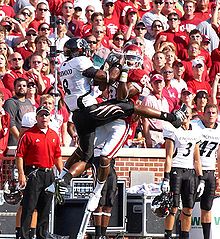 Ryan Broyles of the 2008 squad goes up to catch a pass from quarterback Sam Bradford.
Ryan Broyles of the 2008 squad goes up to catch a pass from quarterback Sam Bradford.
The 2007 Oklahoma team opened up with a home game against the University of North Texas and soundly beat them 79–10. The 79 points scored by OU was the most in the country for Week 1. In Week 2 the Sooners played a much tougher opponent in the University of Miami. However, the results seemed to show a mismatch, as OU easily defeated the Hurricanes 51–13. In Week 3 the Sooners got the best of Utah State with a 54–3 thrashing. Week 4 matched OU up with an in–state foe, the Tulsa Golden Hurricanes. Just as it had been all season (except for the Sept. 29 loss at unranked Colorado), the Sooners put up another dominant performance with a 62–21 victory. In Week 5 (September 29, 2007), the #4 Sooners saw their National Championship hopes take a hit as they lost to 2–2 unranked Colorado in Boulder 27-24 after leading in the second half by a score of 24-7. The Sooners only had 234 net yards compared to Colorado's 379 net yards. The 2007 match-up between Oklahoma and Texas on Oct. 2007 was predicted to be the #3 game to watch in 2007 by SI.com's "Top 20 Games To Watch In 2007" list. The University of Oklahoma football team proved itself worthy of the top ten rankings when it defeated Texas 28-21 at the Red River Rivalry. The Texas Longhorns played up to their potential when they answered almost every point during the October 6 game. In the end Colt McCoy along with Jermichael Finley and the Longhorns could not withstand the adamant pressing of Sam Bradford, Demarco Murray and the Sooners.[44] Oklahoma would go on to lose to an unranked Texas Tech team in an upset, although this was not enough to keep them from the Big 12 championship. They would go on to defeat Missouri in the Big 12 championship game and win the Big 12's automatic BCS berth, playing West Virginia University in the Fiesta Bowl. For the second consecutive year Oklahoma would lose to an underdog opponent in a BCS bowl game, although this game was not as close as the previous year. Oklahoma was down 14 points at halftime and never pulled close than 20–15, eventually losing 48-28.
The Sooners opened 2008 ranked fourth in both the Associated Press Poll and the USA Today Coaches' Poll. Opening with back to back home victories against Chattanooga and Cincinnati and scoring over 50 points against both opponents would vault Oklahoma to number two in both polls, coupled with, then number three, Ohio State's loss and a lackluster victory by, then number two, Georgia over South Carolina. A road victory at Washington where the Sooners again scored more than 50 points, a home victory over then undefeated and 24th ranked Texas Christian University, and a road win at Baylor resulted in Oklahoma being ranked number one in both polls after then-ranked number one USC tumbled after a defeat at Oregon State. The Sooners had defeated each of their first five opponents by 25 points or more before facing then-number five Texas. In a see-saw battle where Oklahoma would take their last lead at 35–30, Texas would come from behind with 15 unanswered points to upset the Sooners at a neutral field by a final score of 45-35. The Sooners could muster up only 48 rushing yards while giving up 161. Also of note, the Sooners failed to convert on three fourth down attempts and Bradford threw two interceptions. Oklahoma would fall to number four in the AP Poll and number six in the USA Today Poll, while the Longhorns would be the new number one team in both polls. The game would result in controversy later in the season. Oklahoma would rebound by defeating then-ranked sixteen Kansas at home and a road win at Kansas State. By the Week 8 rankings, Oklahoma would be ranked fourth in the AP Poll, fifth in the USA Today Coaches' Poll, and debut at fourth in the BCS behind undefeated Texas, Alabama, and Penn State. The Sooners would then go on to defeat their next three opponents by more than 30 points each, scoring 60 or more points. A home victory over Nebraska, and road wins at Texas A&M and then-ranked #2 Texas Tech would result in some controversy. Along with an upset of Texas at the hands of Texas Tech and a previous loss by Penn State against Iowa, Oklahoma was ranked 3 in the Associated Press Poll and number 2 in the USA Today Coaches' Poll ahead of Texas. However, Texas would be number two in the BCS followed by Oklahoma at number three. Alabama would hold number one in all polls with an undefeated record. Closing out the season with a win against Oklahoma State and Alabama's loss to Florida would leave the Sooners at number two in the Associated Press poll, and number one in both the USA Today Coaches' Poll and the BCS. The result of the three-way tie between Oklahoma, Texas, and Texas Tech in the Big 12 South standings, where each team suffered one loss at the hands of the other, would be the cause for many fans, particularly Texas fans, to cry foul. The Big 12 tie-breaker in this scenario was for the team with the highest BCS ranking to go on to play for the Big 12 Title. ,[45] Beating 19th ranked Missouri in Kansas City assured Oklahoma of a number one ranking in both the USA Today Coaches' Poll and the BCS, despite a number two ranking in the Associated Press Poll. Texas would finish number three in all polls, rendering them ineligible to play in the title game. Additionally, quarterback Sam Bradford would win the Heisman Trophy and be named the Associated Press Player of the Year for the 2008 season. On January 8, 2009, the Sooners were defeated by the Florida Gators for the BCS Championship at Dolphin Stadium in Miami by the score of 24-14. This was the fourth time that the Sooners were playing for the National Championship under Coach Stoops. This was the third defeat in the title game under Stoops, the previous two losses in the national championship games were to USC and LSU.
The 2009 season was a challenge for the Sooners. After losing star quarterback Sam Bradford in the first game, and eventually for the whole season, freshman quarterback Landry Jones had to take over. The Sooners ended up with a total of fifteen injuries at the end of the season. The season ended in a 8-5 record. The Sooners went on to beat Stanford in the El Paso Sun Bowl 31-27, setting them up for a title run in the 2010 season.
The 2010 season turned out to be much more successful than the 2009 campaign. The Sooners ended the season with a record of 12-2 and became the Tostito's Fiesta Bowl champions by defeating the University of Connecticut by a score of 48-20 in Glendale, Arizona. This was the first BCS bowl game victory for Bob Stoops and the Sooners since the 2003 Rose Bowl. Marquee victories for the Sooners in 2010 were against the Florida State University Seminoles, Texas Longhorns, Oklahoma State Cowboys and Nebraska Cornhuskers. The Bedlam match-up between the Sooners and Cowboys proved to be the decisive game in who would represent the Big XII South in the conference championship game. The Sooners defeated the Cowboys in a high scoring affair 47-41. The Sooners went on to win the Big XII Championship game 23-20, the final match between conference rival the University of Nebraska.
With star players, Landry Jones, Ryan Broyles, and Travis Lewis coming back for the 2011 season, there are high expectations for Bob Stoops and his Sooner football team. They will begin the season ranked #1 in both the AP and Coaches polls. The Sooners became the first teams to reach the top ranking in the Associated Press poll 100 times since the poll began in 1936.[46] Under Stoops, OU has been ranked No. 1 more weeks than they have not been ranked in the top 25. They were able to accomplish this feat without even stepping foot on the field, as they had their bye week this weekend. Their upcoming early season match-up with fellow top five team Florida State proves to test the Sooners, as they look to prove that their #1 ranking is warranted. As the Sooners played well the first few weeks the Sooners were thought to be out of the National Title race with a heartbreaking loss to the unranked Texas Tech Red Raiders snaping a 39 game home win streak. How ever the Sooners bounced back the following few weeks to go to #5 in the country dispite looseing star reciver Ryan Broyles, only to lose to Baylor for the first time in school history.
The football program remains the primary breadwinner for the Oklahoma athletic program. It accounts for 70% of the Athletic Department's income but just 30% of its expenses.[47]
Record book
- Oklahoma has the most 10+ win seasons (32) and 11+ win seasons (20) of any program, as well as the fewest losing seasons (12) of any program.
- Oklahoma has been ranked No. 1 in the AP Poll (100 weeks)and No. 1 in the Top 5 (374 weeks) more than any team.
- Oklahoma has been ranked No. 1 in all three polls this season, including their 10th appearance as No. 1 in the preseason, another record.
- In the "modern era", which is post-World War II, Oklahoma has the most wins with 567, and the highest winning percentage (.763) in the country (through 2011 Fiesta Bowl).
- Oklahoma has the most wins and best winning percentage in college football over the last 75 years (1935-current).
- Oklahoma is the only school to have played in all five BCS bowl games (Fiesta, Orange, Rose, Sugar and BCS Championship).
- Oklahoma is the only school to have four coaches with at least 100 wins each (Stoops, Switzer, Wilkinson, Owen).
- Oklahoma has had at least one first team all-conference player in 95 of the 96 seasons it has played in a conference.
- Most modern era NCAA-recognized titles with 16.
- Oklahoma holds the NCAA record for most consecutive victories with 47-straight (1953-1957).
- Oklahoma has scored more points than any team in college football history with 31,436 (through the 2011 Fiesta Bowl).
- No program has more unanimous All-Americans than Oklahoma. OU and Notre Dame have 31 all-time.
- ESPN ranked Oklahoma as the most prestigious college football program overall since the advent of the AP Poll in 1936.
- Oklahoma had an NCAA-record 768 rushing yards in 1988 against Kansas State.
- Most weeks ranked No. 1 in the BCS with 20 weeks (through 2010 season).
- Most weeks ranked in top 5 in the BCS with 46 (through 2010 season).
- Oklahoma has the most rushing yards in a season with 5,635 in 1971, which was 470 yards per game (12 games)
- Oklahoma holds the NCAA record for the most points scored in a single season with 702 points through 12 games in the 2008 season (58.5 points per game).
- Oklahoma holds the record for scoring 60 or more points for five consecutive games[48]
- Oklahoma holds the record for most lopsided instate rivalry with a record of 82-16-7 (as of the end of the 2010 regular season) over Big 12 Conference opponent Oklahoma State. In fact the rivalry is so lopsided that Oklahoma has shut out Oklahoma State more times (28 - not including 0-0 ties) than Oklahoma State has won against Oklahoma with the Sooners winning the last 8 games in a row.
- In the 2010 NFL Draft, Oklahoma became the only school in the history of the NFL Draft to have three players selected in the first four picks of the draft.[49]
Current coaching staff
Name Position Bob Stoops Head Coach Jay Norvell Co-Offensive Coordinator/Wide Receivers Coach Josh Heupel Co-Offensive Coordinator/Quarterbacks Coach Brent Venables Defensive Coordinator/Linebackers Coach Bobby Jack Wright Assistant Defensive Coordinator/Defensive Ends Coach Cale Gundy Recruiting Coordinator/Running Backs Coach Bruce Kittle Tight Ends & Offensive Tackles Coach James Patton Centers & Guards Coach Jackie Shipp Defensive Line Coach Willie Martinez Defensive Backs Coach Coaching history
Main article: List of Oklahoma Sooners head football coachesThe team has had 21 head coaches.[50] Oklahoma started organized football with the nickname Sooners in 1895.[51] The Sooners have played in more than 1,100 games in a total of 113 seasons.[51] In those seasons, eight coaches have led the Sooners to postseason bowl games: Tom Stidham, Jim Tatum, Bud Wilkinson, Gomer Jones, Chuck Fairbanks, Barry Switzer, Gary Gibbs, and Bob Stoops. Eight coaches have won conference championships with the Sooners: Bennie Owen, Stidham, Dewey Luster, Tatum, Wilkinson, Fairbanks, Switzer, and Stoops. Owen is the all-time leader in games coached and years coached, while Switzer is the all-time leader in wins and winning percentage. John Harts is, in terms of winning percentage, the worst coach the Sooners have had; he lost the only game he coached, giving him a .000 winning percentage. John Blake has the lowest winning percentage of those who have coached more than one game with .353.[50]
Of the 21 Sooner coaches, Owen, Lawrence Jones, Tatum, Wilkinson, and Switzer have been inducted in the College Football Hall of Fame.[52] Wilkinson, Switzer, and Stoops have each received National Coach of the Year honors from at least one organization. The current coach is Bob Stoops, who was hired in December 1998.[53]
Conferences
From its inaugural season in 1895 until 1914, Oklahoma played as as independent. In 1915, it became a charter member of the Southwest Conference. In 1920, it transferred to the Missouri Valley Intercollegiate Athletic Association. Oklahoma has remained with this conference through its various name changes (Big Six 1929, Big Seven 1948, Big Eight 1959, Big Twelve 1996) until the present day.
Championships
Main article: List of Oklahoma Sooners football championshipsSee also: List of Oklahoma Sooners football seasonsThe Oklahoma Sooners have been a dominant program in every conference they have participated in, from the Southwest Conference to the Big 12 Conference. The team has captured 43 conference titles, including 14 in a row between 1946–59, and the seven national championships: 1950, 1955, 1956, 1974, 1975, 1985, 2000.[54]
On July 15, 2007, Berry Tramel of The Oklahoman (celebrating 100 years of Oklahoma statehood) named the 2000 Oklahoma national title victory against the Florida State Seminoles as the greatest sports event in state history.[55]
Stadium
The Sooners play their home games at Gaylord Family - Oklahoma Memorial Stadium. The stadium was formerly called Oklahoma Memorial Stadium but the administration decided to add 'Gaylord Family' to recognize the contributions made by Edward K. Gaylord and his family over the years (estimated at over $50 million).[56] The playing surface is called Owen Field after Bennie Owen, Oklahoma's coach from 1905 to 1926. The stadium was built in 1923 with an original capacity of 500.[57] In 1925, 16,000 seats were added and 16,000 more seats were added in 1929 bringing the total capacity to 32,000. The stadium has had a natural grass playing surface for the majority of its existence. The stadium had an artificial turf from 1970 to 1994.[57] The stadium had a major renovation in 2003 when a new upper deck was added to the east side of the stadium, adding over 8,400 new seats. The current capacity is 82,112, which makes it the 14th largest college stadium in the U.S. and second largest in the Big 12 Conference.[57] Despite the official capacity, the Sooners average 84,561 in attendance for the 2006 season, nearly 2,500 over capacity.[58]
Pageantry
Rivalries
- Bedlam Series
- Nebraska–Oklahoma football rivalry
- Red River Rivalry
School colors
Crimson Cream Oklahoma's official school colors are crimson and cream.[59] These colors were picked in 1895 by May Overstreet, the only female faculty member at the time. The colors were her own personal choice and she decided on them after viewing many color samples and materials.[60] After her decision, the colors were brought in front of the student body who enthusiastically approved of her selections. In recent years, red and white have sometimes replaced crimson and cream.
Mascot
Oklahoma has had several mascots. The first was a Boston terrier named Mex. Mex was a stray dog found in Mexico during the Mexican Revolution by Mott Keys, an army hospital medic.[11] Keys' company adopted the dog and Keys took the dog back to Hollis, Oklahoma when he completed his duty. When Keys was enrolled in the University, he took Mex with him to Norman. With his experience as an army medic, Keys landed a job with the football team and a residence at the Kappa Sigma fraternity house.[11] Mex's main duty during games was to keep stray dogs from roaming the field. He wore a red sweater with a big "O" letter on the side. Mex received national attention in October 1924 when the Oklahoma football team lost a game against Drake University. Mex was lost when the team boarded a train in Arkansas City, Kansas. The media blamed the loss on the field on the loss of their mascot.[61] Mex was found later by two Oklahoma graduates. Mex died of old age on April 30, 1928. The campus was closed and classes were canceled on the day of his funeral. He was buried in a casket somewhere under the stadium.[11]
Never an official mascot, Little Red began appearing at games in 1953. He was an Indian who wore red tights, breech cloth and a war bonnet and was portrayed by Randy Palmer.[11] In April 1970, Little Red was banished by Oklahoma president J. Herbet Hollomon. The student court issued a temporary restraining order to keep Little Red from appearing at Sooner games.[11] Despite this order, Palmer showed up as Little Red for the 1970 season opener where he was met with cheers from the crowd. When Palmer was drafted after the 1971 season, no one showed up for try-outs to replace him.[11]
The current mascot for Oklahoma is the Sooner Schooner, a conestoga wagon similar to the primary method of transportation used by early settlers in Oklahoma.[61] The Schooner is driven by two white ponies named Boomer and Sooner. In 2005, the university also introduced two costumed mascots also named Boomer and Sooner to serve as mascots for football games and events that do not permit a covered wagon.[61]
Awards
Heisman Trophy
The Heisman Trophy is awarded annually to the nation's most outstanding college football player. Five Oklahoma players have won the Heisman Trophy, six more finished runner-up.
Year Player Position Points 1952 Billy Vessels Halfback 525 1954 Kurt Burris Center 838 1969 Steve Owens Running back 1,488 1972 Greg Pruitt Running back 966 1978 Billy Sims Running back 827 1979 Billy Sims Running back 773 2000 Josh Heupel Quarterback 1,552 2003 Jason White Quarterback 1,481 2004 Adrian Peterson Running back 997 2004 Jason White Quarterback 957 2008 Sam Bradford Quarterback 1,726 Bold indicates winner
Other awards
Maxwell Award[62]
Best player1956 Tommy McDonald - RB 2004 Jason White - QB Walter Camp Award[63]
Best player1969 Steve Owens - RB 1978 Billy Sims - RB 2000 Josh Heupel - QB Dick Butkus Award[64]
Best linebacker1985 Brian Bosworth 1986 Brian Bosworth 2001 Rocky Calmus 2003 Teddy Lehman Bronko Nagurski Trophy[65]
Best defensive player2001 Roy Williams - DB 2003 Derrick Strait - DB Chuck Bednarik Award[66]
Best defensive player2003 Teddy Lehman - LB Davey O'Brien Award[67]
Best quarterback2003 Jason White 2004 Jason White 2008 Sam Bradford Johnny Unitas Golden Arm Award[68]
Best senior quarterback2004 Jason White Jim Thorpe Award[69]
Best defensive back1987 Rickey Dixon[70] 2000 Roy Williams 2003 Derrick Strait Lombardi Award[71]
Best lineman or linebacker1975 Lee Roy Selmon - DT 1985 Tony Casillas - DL 2003 Tommie Harris - DL Outland Trophy[72]
Best interior lineman1951 Jim Weatherall 1953 J.D. Roberts 1975 Lee Roy Selmon 1978 Greg Roberts 2004 Jammal Brown Associated Press College Football
Player of the Year Award[73]
Most Outstanding College Football Player2000 Josh Huepel 2003 Jason White 2008 Sam Bradford Mosi Tatupu Award[74]
Best Special Teams Player2000 J.T. Thatcher All-Americans
Main article: List of Oklahoma Sooners football All-AmericansEvery year, several publications release lists of the their ideal "team." The athletes on these lists are referred to as All-Americans. The NCAA recognizes five All-American lists. They are the Associated Press, American Football Coaches Association, Football Writers Association of America, The Sporting News, and the Walter Camp Football Foundation.[75] Some of these also have levels such as a first team All-American, or second team, or third team. A consensus All-American is determined using a point system; three points if the player was selected for the first team, two points for the second team, and one point for the third team.[75] Oklahoma has had 152 All-Americans[76] (74 consensus) in its history.
See also
- The Pride of Oklahoma Marching Band
- RUF/NEKS
- OU Chant
- List of Oklahoma Sooners in the NFL Draft
Notes
- ^ Cripe, Chadd (December 17, 2006). "Football is a way of life for OU and its fans". Idaho Statesman. http://www.idahostatesman.com/104/story/64105.html. Retrieved 2006-12-19.[dead link]
- ^ "OU No. 1 Program of the Modern Era". SoonerSports.com. http://www.soonersports.com/sports/m-footbl/archive/m-footbl-no1-program-modern-era.html. Retrieved 2007-08-21.
- ^ "SoonerSports.com - Official Site of the Oklahoma Sooners". University of Oklahoma Athletics Department. http://www.soonersports.com/sports/m-footbl/archive/m-footbl-all-americans.html. Retrieved 2010-07-13.
- ^ "Hall of Famers". National Football Foundation's College Football Hall of Fame. http://www.collegefootball.org/famersearch.php?school=Oklahoma&sortby=school. Retrieved 2006-12-20.
- ^ a b c d Keith, Harold (September 1942). "Football Ups and Downs". Sooner Magazine. pp. 12–13, 54. http://digital.libraries.ou.edu/sooner/articles/p12-13,54_1942v15n1_OCR.pdf.
- ^ Burr, Carol (Fall 1998). "If you think football is just a kids' game, you didn't attend the University of Oklahoma" (PDF). Sooner Magazine. p. Inside front cover. http://digital.libraries.ou.edu/sooner/articles/prologue_1998v19n1_OCR.pdf.
- ^ a b c d "Football Coaches". SoonerStats.com. http://soonerstats.com/football/coaches/ou/index.cfm. Retrieved 2006-08-02.
- ^ a b c Clark, J. Brent (1995). Sooner Century: 100 Glorious Years of Oklahoma Football. Quality Sports Publications. ISBN 1-885758-04-9.
- ^ Keith, Harold (July 1946). "Sooner Sports" (PDF). Sooner Magazine. pp. 12–13. http://digital.libraries.ou.edu/sooner/articles/p12-14_1946v18n11_OCR.pdf. Retrieved 2006-09-08.
- ^ Cross, George Lynn (September 1977). Presidents Can't Punt: The OU Football Tradition. Norman, Oklahoma: University of Oklahoma Press. ISBN 0-8061-1419-3.
- ^ a b c d e f g Dozier, Ray (2006). The Oklahoma Football Encyclopedia. Champaign, IL: Sports Publishing, LLC. p. 83. ISBN 1-58261-699-X.
- ^ "OU football tradition - 47 game winning streak". OU. http://www.soonersports.com/sports/m-footbl/archive/m-footbl-winning-streak.html. Retrieved 2010-06-27.
- ^ Budin, Steve with Schaller, Bob (2007). Bets, Drugs, and Rock & Roll: The Rise and Fall of the World's First Offshore Sports Gambling Empire. Skyhorse Publishing. ISBN 1-602-39099-1.
- ^ "Book claims '54 Bedlam Game was fixed by mob". ESPN. http://sports.espn.go.com/espn/news/story?id=3043529. Retrieved 2007-10-02.
- ^ a b c d Burr, Carol (Spring 1987). "Prentice Gautt: A Sooner's Story" (PDF). Sooner Magazine. pp. 10–15. http://digital.libraries.ou.edu/sooner/articles/p10-15_1987v7n2_OCR.pdf.
- ^ "1964 Football Season". SoonerStats.com. http://soonerstats.com/football/seasons/schedule.cfm?SeasonID=1964. Retrieved 2006-08-04.
- ^ Hockman, Ned (January 1965). "Bowled over by a mouthful" (PDF). Sooner Magazine. pp. 22–25. http://digital.libraries.ou.edu/sooner/articles/p22-25_1965v37n3_OCR.pdf. Retrieved 2006-08-04.
- ^ McDade, Larry (March 1966). "Mackenzie Begins" (PDF). Sooner Magazine. pp. 4–7. http://digital.libraries.ou.edu/sooner/articles/p4-7_1966v38n3_OCR.pdf. Retrieved 2006-08-04.
- ^ a b Connors, Bill (September 1967). "Destiny and Charles Fairbanks" (PDF). Sooner Magazine. pp. 4–7. http://digital.libraries.ou.edu/sooner/articles/p4-7_1967v40n1_OCR.pdf. Retrieved 2006-08-04.
- ^ a b All rankings post 1950 are based on the AP Poll.
- ^ Cook, Beano. "The greatest game ever played". ESPN.com. http://espn.go.com/classic/s/beano_oklaneb.html. Retrieved 2007-09-10.
- ^ a b "Season Points Scored Records". SoonerStats.com. http://soonerstats.com/football/recordbook/team/off_pts_season.cfm. Retrieved 2006-08-04.
- ^ "1973 Football Season". SoonerStats.com. http://soonerstats.com/football/seasons/schedule.cfm?SeasonID=1973. Retrieved 2006-08-04.
- ^ "Football Seasons - 1970s". SoonerStats.com. http://soonerstats.com/football/seasons/index.cfm?decade=1970. Retrieved 2006-08-07.
- ^ "Season Rushing Records". SoonerStats.com. http://soonerstats.com/football/recordbook/player/rush_season.cfm. Retrieved 2006-08-07.
- ^ "Career Rushing Records". SoonerStats.com. http://soonerstats.com/football/recordbook/player/rush_career.cfm. Retrieved 2006-08-07.
- ^ "The Winning Margin: Year By Year". Heisman.com. http://www.heisman.com/handbook/winning-margin.html. Retrieved 2006-08-08.[dead link]
- ^ "Football Seasons - 1980s". SoonerStats.com. http://soonerstats.com/football/seasons/index.cfm?decade=1980. Retrieved 2006-08-07.
- ^ Switzer, Barry; Bud Shrake (August 1990). Bootlegger's Boy. William Morrow & Co. ISBN 0-688-09384-1.
- ^ a b c d e Dorsey, Stan (August 19, 1996). "Wanting your children to grow up to be … Sooners". The Sporting News. http://www.findarticles.com/p/articles/mi_m1208/is_n34_v220/ai_18596119. Retrieved 2006-08-07.
- ^ "2009 Division I Football Records Book: Football Bowl Subdivision (FBS) Records". National Collegiate Athletic Association. p. 24. http://web1.ncaa.org/web_files/stats/football_records/DI/2009/2009FBS.pdf. Retrieved 2010-07-09.
- ^ "2000 Football Season". SoonerStats.com. http://soonerstats.com/football/seasons/schedule.cfm?SeasonID=2000. Retrieved 2006-08-07.
- ^ "A remarkable season". BCSFootball.com. http://static.espn.go.com/abcsports/bcs/columns/musburger_brent/2000/1212/940169.html. Retrieved 2006-08-07.
- ^ "Tech scores on 2-yard TD as time expires, avoids upset". ESPN.com. November 19, 2005. http://sports.espn.go.com/ncf/recap?gameId=253232641. Retrieved 2006-12-04.
- ^ "OU must vacate '05 victories. However, Oklahoma will still recognize those eight victories including the Holiday Bowl victory. Bob Stoops' record still stands at 86–18.". The Dallas Morning News. July 11, 2007. http://www.dallasnews.com/sharedcontent/dws/dn/latestnews/stories/071207dnspooulede.c8ab5b.html. Retrieved 2007-07-11.
- ^ "NCAA gives OU back its wins for 2005 season". The Oklahoman. February 22, 2008. http://newsok.com/article/3207494/1203698887. Retrieved 2008-02-22.
- ^ a b "Pac-10 suspends officials for errors that cost Oklahoma". ESPN.com. September 19, 2006. http://sports.espn.go.com/ncf/news/story?id=2593564. Retrieved 2006-12-04.
- ^ "Suspension, apology leaves Stoops unsatisfied". NewsOK.com. September 19, 2006. http://www.newsok.com/article/2849797/?template=sports/ou. Retrieved 2006-12-04.
- ^ Schroeder, George (November 23, 2006). "Gordon Riese's replay revelation". NewsOK.com. http://www.newsok.com/article/keyword/2975982/. Retrieved 2006-12-04.[dead link]
- ^ "Replay official also knew OU recovered kick". MSNBC.com. November 23, 2006. http://www.msnbc.msn.com/id/15867102/. Retrieved 2006-12-04.
- ^ Griffin, Tim (November 30, 2006). "Football: Sooners' defense regains its swagger". San Antonio Express-News. http://www.mysanantonio.com/sports/stories/MYSA120106.01D.FBCou.defense.2a84a90.html. Retrieved 2006-12-04.
- ^ "Ranking Summary". NCAA. http://web1.ncaa.org/d1mfb/2006/Internet/ranking_summary/2006000000522.HTML. Retrieved 2006-12-04.
- ^ "Oklahoma's Peterson returns to practice". Associated Press. 2006-12-08. http://sports.espn.go.com/ncf/news/story?id=2691671. Retrieved 2007-10-12.
- ^ "Top 20 Games To Watch In 2007". SI.com. http://sportsillustrated.cnn.com/multimedia/photo_gallery/0708/top.cfb.games.watch/content.18.html. Retrieved 30 September 2007.
- ^ "2008 Big 12 Championship". RivalsYahoo.com. http://rivals.yahoo.com/ncaa/football/recap?gid=200812060024. Retrieved 2008-12-29.
- ^ "AP ranks Sooners No.1 for 100th time". espn.go.com.
- ^ Burr, Carol (Summer 2006). "Those television dollars: selling point or selling out?". Sooner Magazine.
- ^ "Record Book". SoonerStats.com. http://soonerstats.com/football/coaches/ou/index.cfm. Retrieved 2006-12-21.
- ^ Farmer, Sam (2010-04-22). "Big 12 Dominates NFL Draft". Los Angeles Times. http://articles.latimes.com/2010/apr/22/sports/la-sp-farmer-nfl-draft-20100423. Retrieved 2010-04-23.
- ^ a b OU Athletic Department. "Head Coaches". http://www.soonersports.com/sports/m-footbl/archive/head_coaches.html. Retrieved 2010-05-16.
- ^ a b OU Athletic Department. "Football Year by year season results". http://www.soonersports.com/sports/m-footbl/archive/m-footbl-yr-by-yr-season-results.html. Retrieved 2010-05-16.
- ^ OU Athletic Department. "Hall of Famers". http://www.soonersports.com/sports/m-footbl/archive/m-footbl-hall-of-famers.html. Retrieved 2010-05-16.
- ^ OU Athletic Department. "Bob Stoop Biography". http://soonersports.com/school-bio/bob_stoops.html. Retrieved 2010-05-16.
- ^ "Seven National Championships - Oklahoma Sooners football". http://www.soonersports.com/sports/m-footbl/archive/m-footbl-national-championships.html.
- ^ "The 2001 defensive beatdown of Florida State by Oklahoma stands above all the rest". NewsOK.com. 2007-07-15. http://newsok.com/article/3082952. Retrieved 2007-07-17.
- ^ Shimko, Justin Noel (2002-09-22). "OU Regents OK Stadium Name Change". OU Daily. http://hub.ou.edu/articles/article.php?article_id=1460658802. Retrieved 2007-01-08.
- ^ a b c "Oklahoma Memorial Stadium History". SoonerStats.com. http://www.soonerstats.com/football/stadium/index.cfm. Retrieved 2007-01-08.
- ^ Steele, Phil (2007). "Oklahoma Sooners". Phil Steele's 2007 College Football Preview 13: 82–83.
- ^ "Oklahoma Traditions: Crimson & Cream". SoonerSports.com. University of Oklahoma. http://www.soonersports.com/trads/crimson-creme.html#. Retrieved 2007-08-21.
- ^ The Origin of the University Yell and Colors. Sooner Yearbook. 1916. p. 326.
- ^ a b c "Sooner Schooner & Mascots". SoonerSports.com. University of Oklahoma. http://www.soonersports.com/trads/schooner-mascots.html. Retrieved 2007-08-21.
- ^ "The Maxwell Award: Collegiate Player of the Year - Past Recipients". Maxwell Football Club. http://www.maxwellfootballclub.org/content/awards/maxwell/past_maxwell.htm. Retrieved 2006-12-21.
- ^ Alder, James. "Walter Camp Award Winners". About.com. http://football.about.com/cs/history/a/waltercampaward.htm. Retrieved 2006-12-21.
- ^ Alder, James. "Butkus Award Winners". About.com. http://football.about.com/cs/history/a/butkusaward.htm. Retrieved 2006-12-21.
- ^ "Past Winners of the Bronko Nagurski Trophy". The Touchdown Club. http://www.touchdownclub.com/index.cfm?fuseaction=show_page&page_id=25. Retrieved 2006-12-21.[dead link]
- ^ "Chuck Bednarik Award: College Defensive Player of the Year - Past Recipients". Maxwell Football Club. http://www.maxwellfootballclub.org/content/awards/bednarik/past_bednarik.htm. Retrieved 2006-12-21.
- ^ "Previous Davey O'Brien National Quarterback Award Winners". Davey O’Brien Foundation. Archived from the original on 2006-12-07. http://web.archive.org/web/20061207225123/http://www.daveyobrien.com/Pages/Awards/pastQuarterAward.htm. Retrieved 2006-12-21.
- ^ "Past Winners". Johnny Unitas Golden Arm Educational Foundation. Archived from the original on 2006-12-18. http://web.archive.org/web/20061218182923/http://www.goldenarmfoundation.com/pastwinners.html. Retrieved 2006-12-21.
- ^ "The Jim Thorpe Award - Past Winners". The Jim Thorpe Association. http://www.jimthorpeassoc.org/Awards/JTAPastWinners.html. Retrieved 2006-12-21.[dead link]
- ^ Tied with Bennie Blades of Miami.
- ^ Alder, James. "Lombardi Award". About.com. http://football.about.com/cs/history/a/vincelombardiaw.htm. Retrieved 2006-12-21.
- ^ "ALL-TIME OUTLAND TROPHY WINNERS". Football Writers Association of America. http://www.sportswriters.net/fwaa/awards/outland/winners.html. Retrieved 2006-12-21.
- ^ "AP College Football Player of the Year Award". Associated Press. http://www.fox11online.com/dpp/sports/sports_ap_norman_bradford_ap_player_of_the_year_200812221243_rev1. Retrieved 2008-12-29.
- ^ "The Mosi Tatupu Award - Past Winners". The Maui Quarterback Club. http://en.wikipedia.org/wiki/Mosi_Tatupu_Award. Retrieved 2007-10-03.
- ^ a b "2006 All-American Team announced". NCAA.org. January 12, 2007. http://www.ncaasports.com/football/mens/story/9926097. Retrieved 2007-01-20.
- ^ "142 Oklahoma Football All-Americans". SoonerSports.com. University of Oklahoma. http://www.soonersports.com/sports/m-footbl/archive/m-footbl-all-americans.html. Retrieved 2009-08-31.
Further reading
- Athlon Sports (August 2006). Game Day Oklahoma Football: The Greatest Games, Players, Coaches, And Teams in the Glorious Tradition of Sooner Football. Foreword by Jason White. Triumph Books. ISBN 1-57243-883-5.
- Bosworth, Brian (August 1, 1988). The Boz. Doubleday. ISBN 0-385-24747-8.
- Bruns, Bill (1974). "Sooner": A season as lived and played by Tinker Owens. Josten's Publicatins. ASIN B0006CE382.
- Brush, Daniel J.; David Horne and Marc C. B. Maxwell (2007). University of Oklahoma Football: An Interactive Guide to the World of Sports. Savas Beatie. ISBN 1932714332.
- Clark, J. Brent (October 1995). Sooner Century: 100 Glorious Years of Oklahoma Football. Quality Sports Publications. ISBN 1-885758-04-9.
- Corcoran, Mike (September 28, 2004). The Game of the Century: Nebraska Vs Oklahoma in College Football's Ultimate Battle. Simon & Schuster. ISBN 0-7432-3621-1.
- Cromartie, Bill (March 1982). Annual Madness: A Game by Game History of the Texas-Oklahoma Football Rivalry, 1900–1980. Gridiron Pub. ISBN 0-932520-05-7.
- Cross, George Lynn (September 1977). Presidents Can't Punt: The OU Football Tradition. Norman, Oklahoma: University of Oklahoma Press. ISBN 0-8061-1419-3.
- Dent, Jim (September 24, 2002). The Undefeated: The Oklahoma Sooners and the Greatest Winning Streak in College Football. St. Martin's Griffin. ISBN 0-312-30326-2.
- Dozier, Ray (August 1, 2005). Oklahoma Football Encyclopedia. Sports Pub. ISBN 1-58261-699-X.
- Hartley, Danny (1982). Oklahoma football, the winningest team of the seventies. Western Heritage Books. ISBN 0-86546-036-1.
- Heard, Robert (June 1980). Oklahoma Vs Texas: When Football Becomes War. Honey Hill Pub. ISBN 0-937642-00-2.
- Heupel, Josh (March 26, 2001). The Road to Glory. Contributions by Bob Schaller. Cross Training Publishing. ISBN 1-929478-25-9.
- Keith, Harold (August 2003). Forty-Seven Straight: The Wilkinson Era at Oklahoma. Norman, Oklahoma: University of Oklahoma Press. ISBN 0-8061-3569-7.
- Keith, Harold (July 1978). Oklahoma Kickoff: An Informal History of the First 25 Years of Football at the University of Oklahoma, and of the Amusing Hardships That Attended It. Norman, Oklahoma: University of Oklahoma Press. ISBN 0-8061-1485-1.
- King, Gary T. (July 24, 2006). An Autumn Remembered: Bud Wilkinson's Legendary '56 Sooners. Norman, Oklahoma: University of Oklahoma Press. ISBN 0-8061-3786-X.
- McKenzie, Mike; Jay Upchurch (August 2003). Tales from the Sooner Sidelines: Oklahoma Football Legacy and Legends. Sports Publishing. ISBN 1-58261-320-6.
- Meece, Volney (January 1, 1960). Thirteen years of winning Oklahoma football under Bud Wilkinson. Bryan. ASIN B0007EUM84.
- Shropshire, Mike (August 1, 2006). Runnin' with the Big Dogs: The True, Unvarnished Story of the Texas-Oklahoma Football Wars. William Morrow. ISBN 0-06-085277-1.
- Smith, Jay; William James Willis (August 2003). Prelude to Greatness: Sooner Football in the 1990s. Foreword by David Boren. Norman, Oklahoma: University of Oklahoma Press. ISBN 0-8061-3520-4.
- Snook, Jeff (September 2005). What It Means To Be A Sooner: Barry Switzer, Bob Stoops And Oklahoma's Greatest Players. Forewords by Bob Stoops and Barry Switzer. Triumph Books. ISBN 1-57243-759-6.
- Stallard, Mark (August 25, 2007). Echoes of Oklahoma Football: The Greatest Stories Ever Told. Triumph Books. ISBN 1572438746.
- Switzer, Barry; Bud Shrake (August 1990). Bootlegger's Boy. William Morrow & Co. ISBN 0-688-09384-1.
- Towle, Mike (August 1, 2002). I Remember Bud Wilkinson: Personal Memories and Anecdotes About an Oklahoma Sooners Legend As Told by the People and Players Who Knew Him. Cumberland House Publishing. ISBN 1-58182-301-0.
- Upchurch, Jay (September 2007). Game of My Life: Oklahoma Football. Sports Publishing. ISBN 1-58261-765-1.
- Weeks, Jim (June 1982). The Sooners: A Story of Oklahoma Football. Strode Publications. ISBN 0-87397-220-1.
- Wilkinson, Jay; Gretchen Hirsch (August 1, 1994). Bud Wilkinson: An Intimate Portrait of an American Legend. Sagamore Publishing. ISBN 1-57167-001-7.
External links
Oklahoma Sooners football seasons 1895 • 1896 • 1897 • 1898 • 1899 • 1900 • 1901 • 1902 • 1903 • 1904 • 1905 • 1906 • 1907 • 1908 • 1909 • 1910 • 1911 • 1912 • 1913 • 1914 • 1915 • 1916 • 1917 • 1918 • 1919 • 1920 • 1921 • 1922 • 1923 • 1924 • 1925 • 1926 • 1927 • 1928 • 1929 • 1930 • 1931 • 1932 • 1933 • 1934 • 1935 • 1936 • 1937 • 1938 • 1939 • 1940 • 1941 • 1942 • 1943 • 1944 • 1945 • 1946 • 1947 • 1948 • 1949 • 1950* • 1951 • 1952 • 1953 • 1954 • 1955* • 1956* • 1957 • 1958 • 1959 • 1960 • 1961 • 1962 • 1963 • 1964 • 1965 • 1966 • 1967 • 1968 • 1969 • 1970 • 1971 • 1972 • 1973 • 1974* • 1975* • 1976 • 1977 • 1978 • 1979 • 1980 • 1981 • 1982 • 1983 • 1984 • 1985* • 1986 • 1987 • 1988 • 1989 • 1990 • 1991 • 1992 • 1993 • 1994 • 1995 • 1996 • 1997 • 1998 • 1999 • 2000* • 2001 • 2002 • 2003 • 2004 • 2005 • 2006 • 2007 • 2008 • 2009 • 2010 • 2011
* indicates a national championship yearUniversity of Oklahoma Athletics Facilities Culture Football Seasons · Coaches · In the NFL Draft · Red River Shootout · Red River Shootout trophies · All-Americans · Starting QBs · Current seasonBasketball Other sports Baseball · Baseball coachesCampus List of buildings · Student Union · National Weather Center · Natural History Museum · Museum of Art · Bizzell Memorial Library · Boyd HouseStudent life Big 12 Conference football Current teams Baylor Bears • Iowa State Cyclones • Kansas Jayhawks • Kansas State Wildcats • Missouri Tigers • Oklahoma Sooners • Oklahoma State Cowboys • Texas Longhorns • Texas A&M Aggies • Texas Tech Red Raiders
Future teams Former teams Championships & awards Big 12 Championship Game • Big 12 Conference football individual awards
Categories:- Oklahoma Sooners football
- Sports clubs established in 1895
Wikimedia Foundation. 2010.

